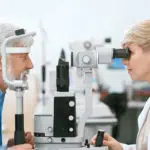Workplace Eye Wellness Month is celebrated in the month of March. It is promoted by many organizations across the U.S. including the American Academy of Ophthalmology, American Optometric Association, and Prevent Blindness. Save Your Vision month falls in March, but there is a special need to address vision and eye-related concerns at the workplace, where so many adults spend hours in front of a digital screen.
History of Workplace Eye Wellness Month
The history of the eye predictably began with the question of solving the mystery of vision. Philosophers like Aristotle were believers of the intromission theory that stated that rays of light entered the eye and made vision possible. The “extramission” theory, which held that eyes give out rays of light, was popular till the 15th century. Leonardo da Vinci changed his own earlier position to support intromission. When it came to visual impairment, the reading stone — similar to a magnifying glass — was one of the first devices to be used as a magnifier beginning in the 9th century or so. The concept of spectacles is recorded in the manuscripts of Arabic scholar, Ibn-al-Heitam, around the 10th century. The first record of spectacles being made was in Italy in the 13th century.
There have been many other advancements in eye wellness including improving spectacles, inventing contact lenses, and developing laser surgery for vision correction. However, the rise of computer usage, especially in the workplace, has increased problems related to vision as more and more people around the world spend more hours in front of digital screens. There is even a syndrome that addresses this problem called Computer Vision Syndrome. This is mostly marked by dry eyes and eye fatigue. It can even lead to headaches and aches in other body parts depending on overall posture.
Workplace Eye Wellness Month draws attention to not just Computer Vision Syndrome but also to other injuries that may occur at the workplace such as wounds from objects, including machines, and specific hazards in some sites like chemical and thermal burns.
Workplace Eye Wellness Month timeline
Arabic genius Abbas ibn-Firnas is credited with developing the first vision enhancement technology for reading.
Murano glassworks in Italy makes the first pair of eyeglasses.
Kevin Tuohy develops the first contact lenses.
The first Lasik eye surgery to correct vision impairment is performed in the U.S.
Workplace Eye Wellness Month FAQs
What are some common workplace eye injuries?
External injury can result from dust, scrap, and other tiny, lightweight objects entering your eye. Any sharp object in the office can also cause serious damage. Chemical burns are a common source of injury for cleaning staff and medical professionals.
Why is it important to protect your eyesight?
“Begin with safe eyes, finish with safe eyes,” is a common slogan about eye safety. This cannot be overemphasized because eyesight is one of our most important senses, the loss of which may cause significant changes in our daily lives.
Which jobs are bad for your eyes?
Jobs that involve touching chemicals and excessive exposure to bright lights or ultraviolet lights, machines, and tools that weld, spray, or cut are high-risk jobs for eye injuries.
How to Observe Workplace Eye Wellness Month
Eat right
Apart from carrots, there are many fruits and vegetables that are good for our eyesight. The “super-ingredient”, beta-carotene, is also available in kale and spinach. Omega-3 and Omega-6 fatty acids are also important for eye health. These are found in fish, microalgae, and evening primrose oil.
Practice good habits and posture
The 20-20-20 rule is a simple and effective practice that all of us can adopt in our daily lives. If you’re sitting in front of a screen for more than 20 minutes, take a break, get up and look at an object 20 feet away for at least 20 seconds. There are other useful practices like keeping your screen at least
Organize a meeting at your workplace
March is a great time to review what your organization is doing to protect employees’ eyesight. You can start a conversation with your team or boss about their experience and decide on steps to improve the situation. Posters are a great way to highlight the importance of the issue and can also provide actionable items for both employers and employees.
5 Facts About Eye Injuries That Will Blow Your Mind
Thousands are affected every day
More than 2,000 American workers face eye injuries every day.
Safety eyewear works
Goggles, face shields, and helmets can mitigate the impact of up to 90% of eye injuries suffered.
Blinking helps
Another very easy rule to practice to avoid eye dryness is blinking regularly.
Blue light is bad for vision
Blue light is emitted by digital screens as well as LEDs and can be stopped by special lenses.
Curved monitors are better
Since curved monitors allow us to look at the full screen easier, it reduces the load on our eyes.
Why Workplace Eye Wellness Month is Important
It’s very relevant
Eye wellness is a topic that is especially relevant in the digital age we live in. Besides specific hazards of injury related to some professions, it is a topic that affects every worker who has to sit in front of a screen.
It raises our awareness
The number of people affected by Computer Vision Syndrome is increasing. However, many of us do not know what can be done at the workplace to improve eye wellness for all. March gives us the opportunity to discuss and agree on better organizational policies to solve the issue.
It reminds us to be healthy
Eye wellness is also an individual goal. Whether it’s wearing a pair of safety goggles when required, or eating nutritious food that’s good for our eyes and body, we need to work towards improving our eye health and preventing injury and disease.
Workplace Eye Wellness Month dates
| Year | Date | Day |
|---|---|---|
| 2025 | March 1 | Saturday |
| 2026 | March 1 | Sunday |
| 2027 | March 1 | Monday |
| 2028 | March 1 | Wednesday |
| 2029 | March 1 | Thursday |





































































































































